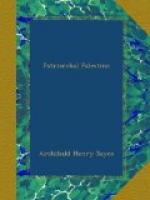We have already seen that long before the time of Ramses II. Jerusalem was an important city and fortress, the capital of a territory of some size, known by the name of Uru-Salim, “the city of the god of peace.” “The city of Salem” could easily be abbreviated into “Salem” only; and it is accordingly Salem which alone is used in the fourteenth chapter of Genesis as well as in the inscriptions of Ramses II. and Ramses III. The name of Rethpana, which follows that of Salem, is faultily written in the list of Ramses II., and it is from that of Ramses III. that we have to recover its true form. Ramses III., moreover, tells us that Rethpana was a lake, and since its name comes between those of Jerusalem and the Jordan it must represent the Dead Sea. The Canaanite form of Rethpana would be Reshpon, a derivative from the name of Resheph, the god of fire and lightning, whose name is preserved in that of the town Arsuf, and whose “children” were the sparks (Job v. 7). The name was appropriate to a region which was believed to have been smitten with a tempest of flames, and of which we are told that “the Lord rained upon Sodom and upon Gomorrah brimstone and fire.”
Khilz, the fourth name in the list, is probably the Babylonian Khalzu, or “fortress.” At all events it was the first town on the eastern side of the Jordan, and it may well therefore have guarded the ford across the river. Karhu is the Korkha of the Moabite Stone, perhaps the modern Kerak, which was the capital of Moab in the age of Ahab, and Uru is the Babylonian form of the Moabite Ar, or “city,” of which we read in the Book of Numbers (xxi. 28). The land of “Moab” itself is one of the countries which Ramses claims to have subdued. The Carmel mentioned in the list is Carmel of Judah, not the more famous Carmel on the coast. As for Tabara or Debir, it will be that ancient seat of Canaanite learning and literature, called Kirjath-Sepher and Debir in the Old Testament, the site of which is unfortunately still unknown. It must have lain, however, between Carmel and Shimshon, “the city of the Sun-god,” with which it is probable that the Biblical Ir-Shemesh should be identified (Josh. xix. 41). Erez Hadashta, “the New Land,” is called Hadashah in the Book of Joshua (xv. 37), where it is included among the possessions of Judah.
The second list, instead of taking us through Judah and Moab, leads us southward along the coast from Mount Carmel. Maghar is termed by Ramses III. “the spring of the Maghar,” and is the Magoras or river of Beyrout of classical geography. The river took its name from the maghdrat or “caves” past which it runs, and of which we have already heard in the Travels of a Mohar. The two next names which represent places on the coast to the north of Gaza are quite unknown, but Sala’, which is written Selakh by Ramses III. (from a cuneiform original), is possibly the rock-city Sela (2 Kings xiv. 7), better known to us as Petra. Of Jacob-el we have already had occasion to speak.




